

There are no rogue traders, there are only rogue banks. Then, in 2008, Jerome Kerviel of Societe Generale lost 4.9 billion euros — about $6.8 billion.
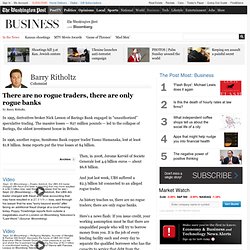
And just last week, UBS suffered a $2.3 billion hit connected to an alleged rogue trader. As history teaches us, there are no rogue traders; there are only rogue banks. Here’s a news flash: If you issue credit, your working assumption must be that there are unqualified people who will try to borrow money from you. Too Big to Fail or Too Big to Change. Two and half years removed from the worst financial crisis since the Great Depression, the investing public has grown increasingly frustrated with the lack of criminal prosecutions of, and absence of truly significant fines levied against, the senior executives and companies responsible for igniting the subprime meltdown.
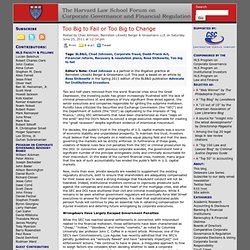
Pundits have criticized the Securities and Exchange Commission (the “SEC”) and the Department of Justice (the “DOJ”) as capitulating to the interests of “big finance,” citing SEC settlements that have been characterized as mere “slaps on the wrist” and the DOJ’s failure to convict a single executive responsible for creating the “great recession” despite significant evidence of intentional misconduct. For decades, the public’s trust in the integrity of U.S. capital markets was a source of economic stability and unparalleled prosperity. Wrongdoers Have Largely Escaped Government Penalties. Andrew Haldane · The Doom Loop: Equity and Banking · LRB 23 February 2012. In 1989, the CEOs of the seven largest banks in the US earned an average of $2.8 million, almost a hundred times the annual income of the average US household.
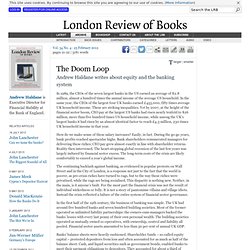
In the same year, the CEOs of the largest four UK banks earned £453,000, fifty times average UK household income. These are striking inequalities. Yet by 2007, at the height of the financial sector boom, CEO pay at the largest US banks had risen nearly tenfold to $26 million, more than five hundred times US household income, while among the UK’s largest banks it had risen by an almost identical factor to reach £4.3 million, 230 times UK household income in that year. How do we make sense of these salary increases? Easily, in fact. Who Wants Big Banks. By James Kwak Thirty years ago, Merton Miller, one of the giants of modern finance, was at a banking conference when a banker said he couldn’t raise more capital by selling stock because that would be too expensive: his stock was selling for only 50 percent of book value.
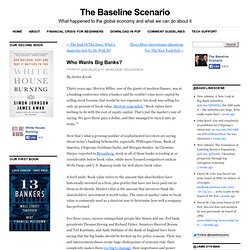
Merton responded, “Book values have nothing to do with the cost of equity capital. That’s just the market’s way of saying: We gave those guys a dollar, and they managed to turn it into 50 cents.”* Now that’s what a growing number of sophisticated investors are saying about today’s banking behemoths, especially JPMorgan Chase, Bank of America, Citigroup, Goldman Sachs, and Morgan Stanley. A brief aside: Book value refers to the amount that shareholders have historically invested in a firm, plus profits that have not been paid out to them as dividends.
But now people who matter (that is, people with real money) are also saying the banks should be broken up—because then they would be worth more to their shareholders. “Summer” Rerun: Why Big Capital Markets Players Are Unmanageable. Willem Buiter's Maverecon. The too big to fail problem has been central to the degeneration and corruption of the financial system in the north Atlantic region over the past two decades.

The ‘too large to fail’ category is sometimes extended to become the ‘too big to fail’, ‘too interconnected to fail’, ‘too complex to fail’ and ‘too international’ to fail problem, but the real issue is size. The real issue is size. Too Big to Fail Not Fixed, Despite Dodd-Frank: Simon Johnson. Here we go again.

Major shocks potentially threaten the solvency of some of the world’s largest financial institutions. Concerns grow over the ability of European leaders to shore up their banks, which are reeling from a sovereign-debt crisis. In the U.S., the shares of some large banks are trading at less than book value, while creditor confidence crumbles. Private conversations among economists, regulators and fund managers turn naturally to so-called resolution powers -- the expanded ability to take over and wind down private financial companies granted to federal regulators by the Dodd-Frank financial reform law.
Huntsman's Warning on 'Too Big to Fail' Simon Johnson, the former chief economist at the International Monetary Fund, is the co-author of “13 Bankers.”
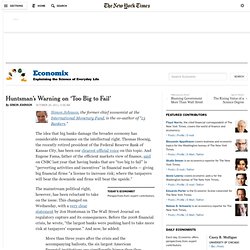
The idea that big banks damage the broader economy has considerable resonance on the intellectual right. Thomas Hoenig, the recently retired president of the Federal Reserve Bank of Kansas City, has been our clearest official voice on this topic. And Eugene Fama, father of the efficient markets view of finance, said on CNBC last year that having banks that are “too big to fail” is “perverting activities and incentives” in financial markets — giving big financial firms “a license to increase risk; where the taxpayers will bear the downside and firms will bear the upside.”
The mainstream political right, however, has been reluctant to take on the issue. This changed on Wednesday, with a very clear statement by Jon Huntsman in The Wall Street Journal on regulatory capture and its consequences. This message could work politically, for five reasons. This is exactly Mr. Mr. Mr. Bill Black: U.S. Subsidies to Systemically Dangerous Institutions Violate WTO Principles. By Bill Black, an Associate Professor of Economics and Law at the University of Missouri-Kansas City.
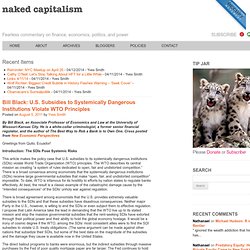
He is a white-collar criminologist, a former senior financial regulator, and the author of The Best Way to Rob a Bank is to Own One. Cross posted from New Economic Perspectives. How Too big to fail creates problems for monetary and financial. Dallas Fed economists Harvey Rosenblum, Jessica Renier and Richard Alm have written an insightful paper on nthe subject.
We all know TBTF is a serious concern but how does it hinder policies? In monetary policy there are 4 transmission channels – securities market channel, asset prices, wealth channel and exchange rate channel. securities market channel operates through money and capital markets, where interest rates generally move in the same direction as the federal funds rate. Changes in the price and availability of nonbank financing influence the borrowing decisions that determine larger businesses’ employment and output decisions. Smaller companies and individuals usually borrow from banks and other financial intermediaries. An asset prices and wealth channel works through interest rate changes’ effect on market prices for a range of assets—such as bonds, equities, and homes and other real estate. Enter banks in monetary policy. What interferes with PCA?
What next? Too big to fail. Act 2 - macrobusiness.com.au. “Summer” Rerun: Why Big Capital Markets Players Are Unmanageable.